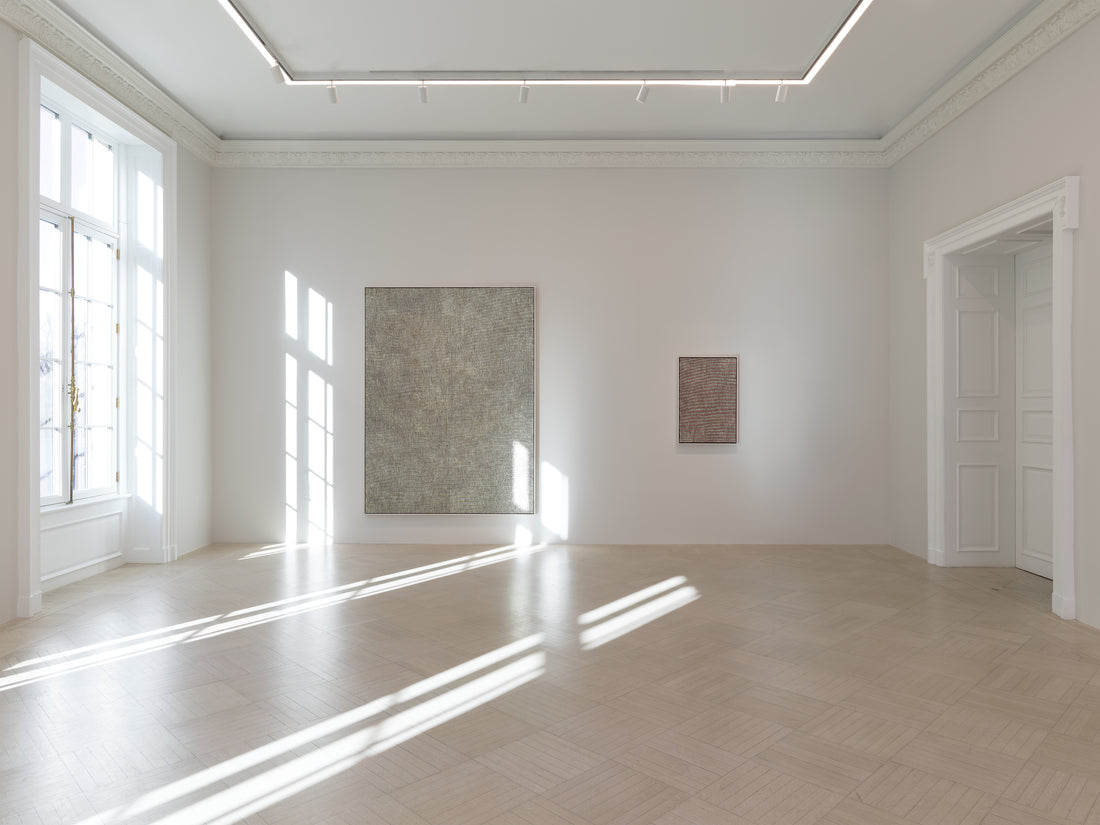January 11 — February 24, 2024
3 E 89th Street
New York, NY 10128
Pintupi woman Mantua Nangala comes from a family of successful Papunya Tula artists. Nangala began to paint for Papunya Tula in 1998 and recalls, “I watched my father (Anatjari Tjampitjinpa) and my husband (Yumpululu Tjungurrayi) painting in the early days and learnt about canvas and paint, and then decided that I wanted to make canvas as well.”1 Many of her paintings depict the journey of the Kanaputa women who traveled from the west through Mukula, Marrapinti, and Yunala—sacred places of ceremony and gathering for Pintupi women. In many of her works, Nangala employs a “traditional” color palette of earth tones, typical of Papunya Tula men’s paintings from the 1970s to 1990s.

Nangala’s paintings are characterized by rich strings of fine dots, the configurations of which evoke a sense of movement across the canvas. The sinuous collection of dots most accurately represents the sand dunes that occupy much of Pintupi Country. Though Nangala’s works may appear simple in composition, they are a complex continuation of Papunya Tula artistry, telling a layered story about the history of her people and Country. While her works all differ slightly in tone, Nangala often restricts her acrylics to five or so colors per painting, allowing each work to generate an atmospheric depiction of her homelands. In an interview with Kalkadoon and Eastern Arrernte curator Hetti Perkins, Nangala explained, “I like to make my paintings slowly, every dot slowly and carefully”2—an attention to detail that is part of what makes Nangala such a respected senior artist.
Another Pintupi artist who enthralls viewers both in Australia and abroad is Yukultji Napangati. Napangati lived a nomadic lifestyle with her kin, having no knowledge of or contact with Western civilization, until her family, referred to as the Pintupi Nine, arrived in Kiwirrkurra in 1984. After watching her male relatives work with Papunya Tula, Napangati began to develop her own practice in the 1990s. Like Nangala, she paints with acrylic on canvas, depicting important ceremonial places for Pintupi women, including the rock hole site of Marrapinti, west of the Pollock Hills in Western Australia. Napangati highlights her connection to Pintupi Country in all of her works, emphasizing the positive impact growing up away from settler structures had on her.

Many of Napangati’s paintings, especially her early works, use red, yellow, black, and white acrylics that best capture the coloring of the Western Desert. This minimal palette allows viewers to understand the richness of the landscapes being depicted. In recent years, the artist has experimented with blue and monochromatic tones, offering a new, abstract way of considering Pintupi Country. All of Napangati’s canvases are lined with twisting trails of dots; similarly to Nangala’s painting, her careful execution of undulating lines generates movement across the canvas, reflecting the varying topography of her homelands. Some lines are composed of tight formations while others are looser strokes, giving the piece a sense of depth. Napangati is particularly well known for her addition of tight oscillating shapes in some of her works, which give a sense of dynamism to her practice. By interrupting the undulating lines, these structures generate a new pulse in her paintings.
Both Nangala’s and Napangati’s paintings capture what W.E.H. Stanner referred to as “everywhen.”3 By this, the renowned anthropologist meant that Indigenous connections to Country and creation stories known as the Dreaming4 cannot be fixed at one point in time, for Aboriginal notions of temporarily are not synonymous with those in the Western world. The ancestral women, locations, and stories captured by Nangala and Napangati (as well as the five other artists in the exhibition) are always relevant and exist at every point in time. Their paintings encapsulate this immortality—the importance of stories that exist everywhen. This speaks to the importance of connection to Country in the Western Desert, as the Pintupi and Pitjantjatjara artists in Desert + Coast all remain strong in their links to community and culture.
Essay by: Shanysa McConvill.
Publication © 2024 Salon 94.
ISBN 978- 0- 9778807-2-0.



